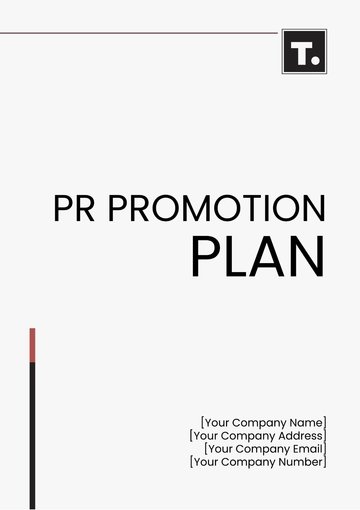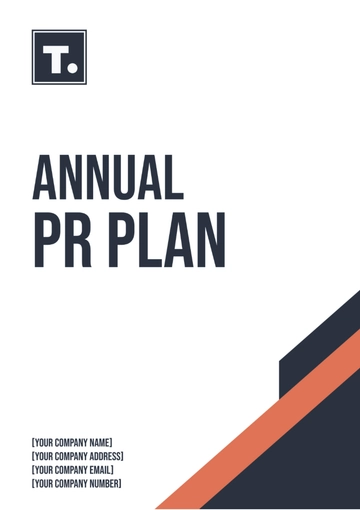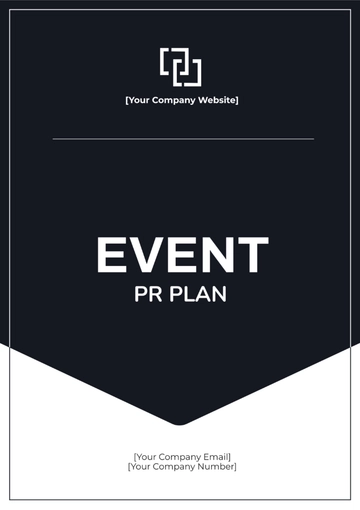Free PR Research Plan

I. Introduction
In this PR Research Plan, we outline the strategies and methodologies for conducting research to inform the development of effective PR campaigns. By gathering comprehensive data and insights, we aim to create targeted and impactful campaigns that resonate with our target audience and support our organizational objectives.
II. Objectives
Market Landscape Understanding: Conduct thorough research to understand the current market landscape, including industry trends, challenges, and emerging opportunities relevant to products and services.
Audience Insights: Gain actionable insights into the perceptions, preferences, and behaviors of our target audience segments to tailor our PR messaging and campaigns effectively.
Competitor Analysis: Analyze competitor PR strategies, messaging tactics, and media presence to identify areas for differentiation and competitive advantage.
Performance Measurement: Establish clear benchmarks and key performance indicators (KPIs) to measure the success and impact of our PR campaigns over time.
III. Research Methodologies
1. Market Analysis
Conduct comprehensive industry research utilizing both primary and secondary sources, including industry reports, market studies, and relevant academic research.
Analyze market segmentation and identify key market segments for targeting based on demographics, psychographics, and behavioral factors.
2. Audience Research
Deploy a mixed-method approach, including surveys, focus groups, and in-depth interviews, to gather insights into the attitudes, beliefs, and preferences of our target audience.
Utilize social media monitoring tools and online analytics platforms to track online conversations, sentiment, and engagement related to [YOUR COMPANY NAME] and its products/services.
3. Competitor Analysis
Identify direct and indirect competitors operating within the industry vertical.
Conduct a SWOT (Strengths, Weaknesses, Opportunities, Threats) analysis of competitors' PR efforts to identify areas for improvement and strategic positioning.
IV. Data Collection
Data Collection Method | Description |
|---|---|
Primary Research |
|
Secondary Research |
|
V. Analysis and Interpretation
1. Quantitative Analysis
Utilize statistical software packages to analyze survey data and identify statistically significant trends, correlations, and patterns.
Generate charts, graphs, and visualizations to illustrate key findings and insights derived from quantitative analysis.
2. Qualitative Analysis
Conduct a thematic analysis of focus group transcripts and qualitative survey responses to identify recurring themes, sentiments, and perceptions.
Employ text analysis tools and sentiment analysis algorithms to gauge public sentiment towards its products/services.
VI. Actionable Insights
Based on the research findings, we will develop actionable insights to inform the development of PR campaigns. These insights will include:
Insights | Description |
|---|---|
Key Messaging Themes | Identify core messaging themes and narratives that resonate with target audience segments and align with brand values and positioning. |
Media Channels and Outreach | Determine effective media channels, platforms, and influencers for disseminating PR messages and engaging with target audiences. Develop targeted outreach strategies to maximize visibility and impact. |
Stakeholder Engagement | Develop strategies for engaging key stakeholders, including customers, industry influencers, and media contacts, to amplify PR efforts and build brand credibility and trust. |
VII. Conclusion
By following the outlined research methodologies and analysis processes, we aim to gather valuable insights that will drive the development of impactful PR campaigns. Through continuous monitoring and evaluation, we will ensure that our PR efforts are aligned with our organizational goals and effectively reach our target audience.
- 100% Customizable, free editor
- Access 1 Million+ Templates, photo’s & graphics
- Download or share as a template
- Click and replace photos, graphics, text, backgrounds
- Resize, crop, AI write & more
- Access advanced editor
Boost your PR strategy with Template.net's PR Research Plan Template. This highly customizable and editable template simplifies your workflow, ensuring thorough research and effective communication plans. Utilize the AI Editor Tool for seamless adjustments, making it perfect for professionals seeking efficiency and accuracy in their PR campaigns. Get started today!
You may also like
- Finance Plan
- Construction Plan
- Sales Plan
- Development Plan
- Career Plan
- Budget Plan
- HR Plan
- Education Plan
- Transition Plan
- Work Plan
- Training Plan
- Communication Plan
- Operation Plan
- Health And Safety Plan
- Strategy Plan
- Professional Development Plan
- Advertising Plan
- Risk Management Plan
- Restaurant Plan
- School Plan
- Nursing Home Patient Care Plan
- Nursing Care Plan
- Plan Event
- Startup Plan
- Social Media Plan
- Staffing Plan
- Annual Plan
- Content Plan
- Payment Plan
- Implementation Plan
- Hotel Plan
- Workout Plan
- Accounting Plan
- Campaign Plan
- Essay Plan
- 30 60 90 Day Plan
- Research Plan
- Recruitment Plan
- 90 Day Plan
- Quarterly Plan
- Emergency Plan
- 5 Year Plan
- Gym Plan
- Personal Plan
- IT and Software Plan
- Treatment Plan
- Real Estate Plan
- Law Firm Plan
- Healthcare Plan
- Improvement Plan
- Media Plan
- 5 Year Business Plan
- Learning Plan
- Marketing Campaign Plan
- Travel Agency Plan
- Cleaning Services Plan
- Interior Design Plan
- Performance Plan
- PR Plan
- Birth Plan
- Life Plan
- SEO Plan
- Disaster Recovery Plan
- Continuity Plan
- Launch Plan
- Legal Plan
- Behavior Plan
- Performance Improvement Plan
- Salon Plan
- Security Plan
- Security Management Plan
- Employee Development Plan
- Quality Plan
- Service Improvement Plan
- Growth Plan
- Incident Response Plan
- Basketball Plan
- Emergency Action Plan
- Product Launch Plan
- Spa Plan
- Employee Training Plan
- Data Analysis Plan
- Employee Action Plan
- Territory Plan
- Audit Plan
- Classroom Plan
- Activity Plan
- Parenting Plan
- Care Plan
- Project Execution Plan
- Exercise Plan
- Internship Plan
- Software Development Plan
- Continuous Improvement Plan
- Leave Plan
- 90 Day Sales Plan
- Advertising Agency Plan
- Employee Transition Plan
- Smart Action Plan
- Workplace Safety Plan
- Behavior Change Plan
- Contingency Plan
- Continuity of Operations Plan
- Health Plan
- Quality Control Plan
- Self Plan
- Sports Development Plan
- Change Management Plan
- Ecommerce Plan
- Personal Financial Plan
- Process Improvement Plan
- 30-60-90 Day Sales Plan
- Crisis Management Plan
- Engagement Plan
- Execution Plan
- Pandemic Plan
- Quality Assurance Plan
- Service Continuity Plan
- Agile Project Plan
- Fundraising Plan
- Job Transition Plan
- Asset Maintenance Plan
- Maintenance Plan
- Software Test Plan
- Staff Training and Development Plan
- 3 Year Plan
- Brand Activation Plan
- Release Plan
- Resource Plan
- Risk Mitigation Plan
- Teacher Plan
- 30 60 90 Day Plan for New Manager
- Food Safety Plan
- Food Truck Plan
- Hiring Plan
- Quality Management Plan
- Wellness Plan
- Behavior Intervention Plan
- Bonus Plan
- Investment Plan
- Maternity Leave Plan
- Pandemic Response Plan
- Succession Planning
- Coaching Plan
- Configuration Management Plan
- Remote Work Plan
- Self Care Plan
- Teaching Plan
- 100-Day Plan
- HACCP Plan
- Student Plan
- Sustainability Plan
- 30 60 90 Day Plan for Interview
- Access Plan
- Site Specific Safety Plan






















